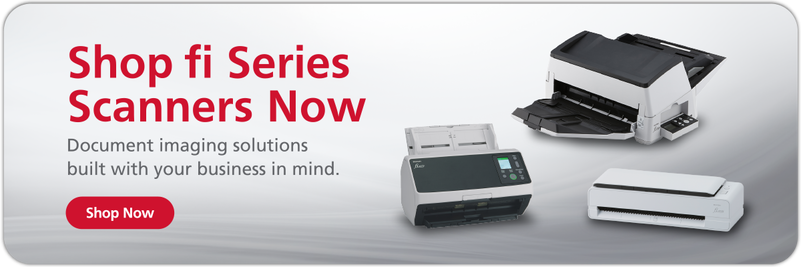Buying a flatbed scanner may look straightforward, but no two models are quite alike.
Flatbed scanners are among the most common scanners in business settings for a good reason. Not only does their design support a wide array of document types, but they're also intuitive enough for users of all technical skill levels to operate.
And yet, for all the benefits of flatbed scanners, choosing the right one can be a challenge. The industry supports a diverse range of models, from small, manually-operated devices to complex units with integrated document feeders. In addition, most of these scanners are intended for specific business needs, making it essential to understand all available features before making a purchase.
Check out our guide, The 11 Types of Scanners Every Pro Needs to Know, for even more expert advice and information or shop our best flatbed scanners here.
Jump to a section:
- What is a document flatbed scanner and how does one work?
- What are the benefits of flatbed scanners?
- Flatbed scanner: Key features to consider
- Here are some other features to expect from the best flatbed scanners:
- Tips for getting the best quality scans from a flatbed scanner
- Who should use a flatbed scanner?
- Why purchase an 11x17 flatbed scanner?
- Our recommendation: fi-8270 and ScanSnap SV600
What is a document flatbed scanner and how does one work?
A document flatbed scanner is a type of optical scanner that uses a flat surface to assist with the scanning process, rather than running materials through a feeder. Flatbed scanners are the ideal choice for scanning bound materials like books and periodicals, as well as particularly thick or delicate documents.,
To capture images, a flatbed scanner uses a glass plate, a motorized light source, a series of mirrors and lenses, and an imaging sensor. First, a user lays a document flat against the glass plate and closes the lid. Then, the light source illuminates each part of the document while the mirrors and lenses reflect and transmit the image. The sensor converts the image to digital information. From there, computer scanning software can save the image in a usable file format.
A flatbed scanner’s design gives it a few potential advantages over a document feeder scanner. First and foremost, paper in a flatbed scanner remains stationary. That means there’s no way for thick pages to get stuck and create a paper jam. Furthermore, flatbeds won’t damage delicate documents by bending or tearing them.
What are the benefits of flatbed scanners?
Flatbed scanners are invaluable for industries that handle fragile and valuable materials. Since objects do not move during the scanning process, flatbeds minimize the chances of damaging each object while producing a high-quality image.
The largest benefit of a flatbed scanner is its ability to work with all manner of items, including those that are oddly sized, extra large, fragile, bound, but that’s far from the only advantage they provide. They’re also generally inexpensive and easy to use. The flat scanning surface combined with an adjustable lid is well suited to common businesses scanning needs, such as:
- Standard documents
- Photographs
- Government-issued ID cards
- Books
- Flat artwork and canvas paintings
Flatbed scanner: Key features to consider
Flatbed scanners are versatile and effective devices, but no two models are alike. That’s because today’s market supports a variety of sizes and features that may not be useful in all work environments. Before making a purchase, evaluate your immediate needs by asking the following questions:
- What are you scanning? While flatbed scanners are versatile, you should be absolutely sure they support the documents or objects you need to reproduce.
- How delicate are the scanned objects? Flatbeds are ideal for preserving vintage photographs, books, and documents that may require special considerations for handling.
- Do you need to scan multiple documents at a time? If users are scanning a high volume of images, it may be helpful to purchase a model with an automated document feeder.
- What is the largest document you will scan? Scanning 8.5” x 11” documents generally requires less space than oversized books.
- How vital is scan quality? Flatbed scanners support a variety of resolutions, often 1,200 dots per inch or higher.
- Can users easily change its settings? If users need to adjust the scanning space or resolution, they will likely need to access a control panel for specialized settings. An intuitive interface will be essential if the general public has access to these options.
Did You Know? If you need a flatbed scanner that can scan double-letter, check out the fi-7700. If you need an overhead scanner that can handle delicate or oversized documents, consider the ScanSnap SV600.
Here are some other features to expect from the best flatbed scanners:
Scan resolution
One of the most important considerations for any document scanner is image quality. Manufacturers typically achieve this quality in optical resolution, which is the maximum recommended dots per inch (DPI) for the device. Flatbed scanners can range from 50 DPI to 4800 DPI, depending on your model.
It’s important to note that a lower optical DPI does not equate to a low-quality scanner. High DPIs sound impressive but they also significantly reduce scan speed, limiting them to specific use cases. Most businesses will never need that kind of resolution. While a high DPI like 600 or above will give much better reproduction of images, it is often overkill for document archiving or electronic transfer, with the industry average being 300. Another downside to high resolution is a mathematical increase in the file size with every 100 DPI; high resolution equates to high storage costs.
Color quality
Grayscale digitization is ideal for many business documents that don’t make use of color, and this method can be preferable for creating files that take up less digital storage space than capturing true color. However, if you’re scanning materials such as artistic prints, magazines, or anything else where color is a key part of the image, you should keep an eye out for a flatbed scanner that can capture not just high resolution but also true-to-life color images.
Size of the flatbed
One key differentiation point between the best flatbed scanners is the dimensions of their flatbeds. Most flatbed scanners support documents of standard A4 letter size, while an 11x17 flatbed scanner can comfortably tackle an entire A3 document in one pass. Make sure you account for the typical size of documents that your organization will need to digitize when picking out your preferred model.
Automatic Document Feeder
Flatbed scanners may include an automatic document feeder to process a steady stream of files quickly and efficiently. This automation is crucial when users manage a high volume of documents and cannot spare the time to process them manually via the flatbed. However, automated feeders may not be necessary if the scanner will only be used for specialized items, such as fragile photographs that must be handled carefully.
Speed of the flatbed
Scanning documents with a flatbed scanner will always be slower than putting a stack of pages through an Automatic Document Feeder chute, because the user must manually change out each page. However, fast scanning speeds can still cut down on overall time investment. Some of the best flatbed scanners are capable of digitizing a standard letter sheet of paper in just over half a second in landscape mode, facilitating a more efficient workflow.
Coverless scanning
Flatbed scanning is typically done by placing a document on the scanner’s digitization surface then lowering a cover over it. The cover keeps the document in place and minimizes both dust and light contamination from the operating environment. However, flatbed scanners that support coverless scanning allow you to leave the cover open whilst digitizing documents. This is helpful both for speeding up the process and for scanning the surface of larger or awkwardly sized documents that may not fit under the cover.
Federal compliance
Document scanning is not always as simple as reproducing and storing digital images. Many federal and state compliances dictate how records are managed, especially in hospitals and government offices. In these cases, employees may need additional guarantees that their flatbed scanner meets regulations and performance expectations.
Unfortunately, these standards may not always be evident by looking at a product page. If necessary, review the brand’s website to see what kind of compliance solutions apply to all supported products.
Did You Know? Many scanners are trade-compliant. Take a closer look at our government-level solutions for more details.
Tips for getting the best quality scans from a flatbed scanner
Once you’ve purchased and set up your flatbed scanner, you may want to optimize your image quality. There are a few steps you can take to get crisp, clean, lifelike scans every time:
- Clean the glass plate: Even if you keep the lid closed while you’re not using it, the glass plates in flatbed scanners tend to attract dust and fingerprints. A wipe with a microfiber cloth should get the job done, but you can also use a small amount of distilled water or glass cleaner to ensure the scanning glass is spotless.
- Lay documents flat as possible: While flatbed scanner lids prevent paper from moving around, they may not keep creased or folded documents perfectly flat. That could lead to distorted, hard-to-interpret image files. Before you scan a sheet of paper, flatten it as much as possible. Laying a heavy book on top of the document for a few hours is an effective way to gently work out folds or creases.
- Use black construction paper: If you’re scanning double-sided text documents, some words from the opposite side of the page could bleed through. To prevent this, lay a piece of black construction paper on top of the document you want to scan. The added weight will also help keep the paper flat. Some scanners have a black background option.
- Adjust your scanning software: Most scanning software has various options for resolution, color, paper size, text recognition, and other useful features. Try scanning a document a few times using different software settings. See which one gets you the best results.
Who should use a flatbed scanner?
While flatbed scanners aren’t as fast as their document feeder counterparts, they can scan a much wider variety of items. People who wish to scan photos, magazines, books, identification cards, and other items with irregular dimensions are probably better off using flatbed scanners. Additionally, flatbed scanners are useful for genealogists and historians, as these devices are less likely to damage old and delicate documents.
If the items in question are extremely fragile, however, it’s also worth considering an overhead scanner, such as the ScanSnap SV600. These scanners don’t require physical contact with the document in question, as they capture images from about a foot above. Overhead scanners tend to be slower than flatbeds, but there’s less risk of damaging irreplaceable artifacts.
Why purchase an 11x17 flatbed scanner?
Flatbed scanners are accessible over other designs because anyone can place documents on the scanning surface to create high-quality images. But, of course, that process works only if the flatbed glass is large enough to support any object! Large flatbeds accommodate the broadest range of documents, from oversized sheets to entire book spreads.
The tradeoff for size is measured in your remaining workspace. Even a modestly-sized flatbed scanner can be bulky, and larger models will take up far more room on a desk. Businesses that often scan large documents should consider preparing a dedicated scanning workstation with an 11” x 17” flatbed scanner that meets almost every need. However, if letter-sized paperwork is more common, look for something closer to the standard 8.5” x 11” size.
Our recommendation: fi-8270 and ScanSnap SV600
Those in the market for a flatbed scanner have no shortage of options. At Ricoh, we take great pride in having spent the last 70+ years researching, designing and developing some of the most advanced and powerful electronics in the world, including our production grade fi series of scanners.
Built to purpose for the most demanding document handling jobs, Ricoh fi Series scanners are capable of processing tens-of-thousands of pages per day at the highest levels of accuracy. Their intuitive integration capabilities with all existing work suites minimize time-to-value for businesses looking to invest in tools that will pay dividends for years to come.
When looking for an innovative and superior experience, we proudly recommend the fi-8270, which offers versatile scanning as a flatbed and automated document feeder. It supports an optical resolution of 600 DPI, providing quick scans in 1.7 seconds ipm as a flatbed, and 70 ppm/140 ipm from the document feeder. The fi-8270 scans many types of documents, including passports and booklets, and includes a color LCD panel for easy operation.
Alternatively, those looking for an overhead scanner should consider the ScanSnap SV600. With support for documents up to 30 mm thick, The SV600 is ideally suited for newspapers, magazines, books, and other items that may not fit easily into a flatbed model — including delicate documents that may not stand up to repeated handling. The device lets users scan pages at fixed intervals so that they don’t have to press the scan button each time. Click here to learn more or shop the rest of our production scanner line.

Note: Information and external links are provided for your convenience and for educational purposes only, and shall not be construed, or relied upon, as legal or financial advice. PFU America, Inc. makes no representations about the contents, features, or specifications on such third-party sites, software, and/or offerings (collectively “Third-Party Offerings”) and shall not be responsible for any loss or damage that may arise from your use of such Third-Party Offerings. Please consult with a licensed professional regarding your specific situation as regulations may be subject to change.













